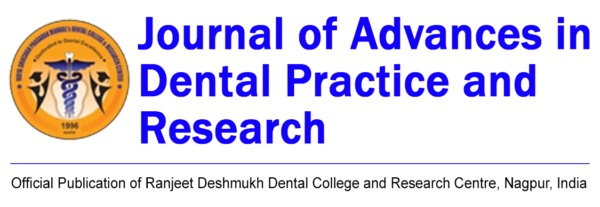Translate this page into:
Equitable access to oral care services: Still a dream or reality?
*Corresponding author: Saee Deshpande, Department of Prosthodontics, Ranjeet Deshmukh Dental College and Research Centre, Nagpur, Maharashtra, India. saeedeshmukh@vspmdcrc.edu.in
-
Received: ,
Accepted: ,
How to cite this article: Deshpande S. Equitable access to oral care services: Still a dream or reality? J Adv Dental Pract Res. 2024;3:1. doi: 10.25259/JADPR_43_2024
Over 3.5 billion individuals worldwide suffer from oral disorders, which are extremely common conditions, even though they are mostly preventable. Significant repercussions and consequences result from oral disorders, including pain and infection, a lower quality of life, missed work and school days, disruptions to the family, and a decrease in productivity at work.
The majority of people in India have oral health problems. The World Health Organization (WHO) reports that more than 50% of adults in India have periodontal disease and more than 95% of adults have dental caries. Public awareness must be increased, and it must be made available to all.
Dental care can be expensive for the patient as well as the larger healthcare system. The frequency and severity of oral disorders, as well as oral health, are influenced by numerous factors. A significant barrier to reaching ideal oral health, nevertheless, is still getting access to sufficient, high-quality, and reasonably priced dental care.
Oral health equity is achieved when everybody has the most equitable and just opportunity to reach optimal health. Tooth decay and gum disease disproportionately affect those from rural and low-income areas, minorities such as LGBTQ community, people with physical and intellectual disabilities and the elderly. These groups also have lower dental visit rates than the general Indian population.
A dentist to population ratio of 1:7500 is advised by the WHO. India’s dentist-to-population ratio is at 1:10,000, down from 1:300,000 in the 1960s. There is a stark contrast in the distribution of dentists between urban and rural locations; in rural areas, no geographical provisions have been made to provide dental care.
There are several ways to deal with this issue which requires collaborative efforts of governmental bodies as well as dental professionals.
First, we need to create more public awareness regarding oral health and its significance in overall general health and quality of life.
We need to also improve distribution of dental services in rural areas by appointing dentists at primary health centers. Studies undertaken worldwide have shown that allied health professions can effectively reduce oral health disparities, improve access, and disseminate health promotion messages across the whole socioeconomic spectrum.
Last but not the least, periodic epidemiological investigations to monitor the oral health outcomes and needs of the general population will go in a long way to attaining sustainable oral health equity in our country.





